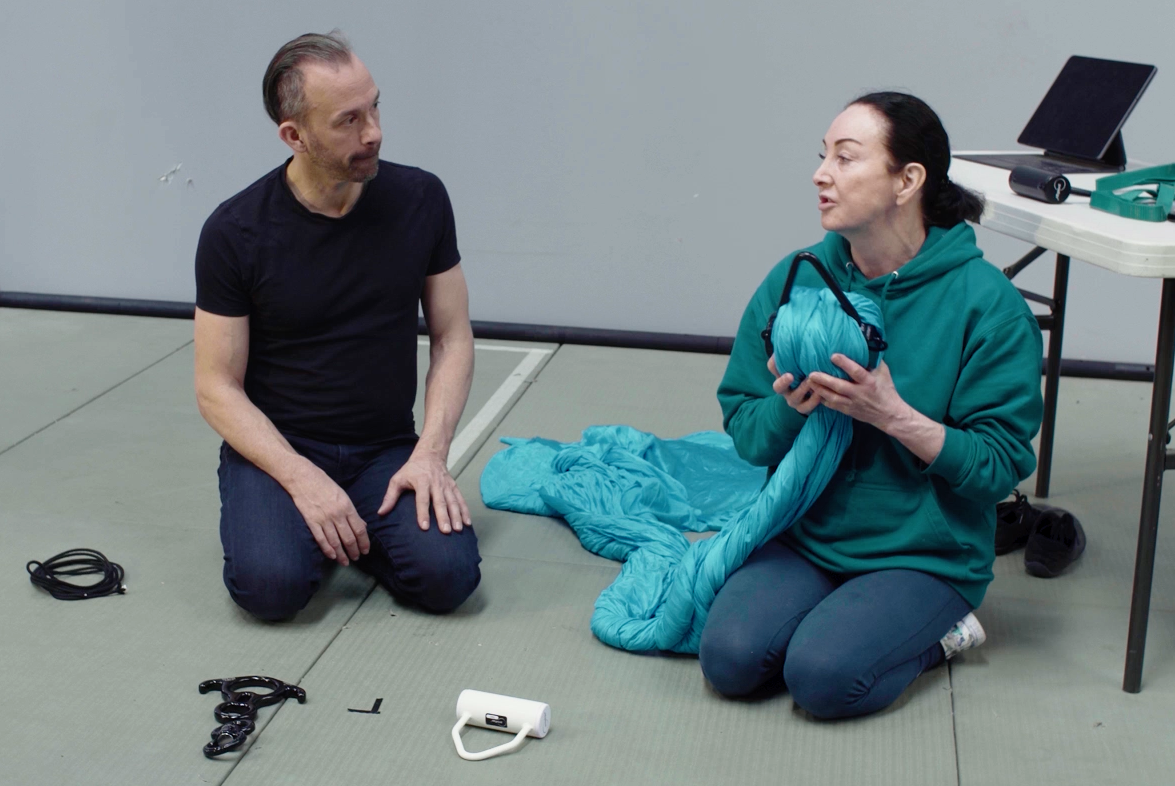Selecting Your Silks

This article is designed to be used alongside six Circus Safety & Rigging videos with Mark Gibson from Aerial Edge, Glasgow’s Circus School, and Catherine Knowles, from Community Circus Paisley. There are also two other articles: rigging and maintaining your silks. You’ll find the first video and links to everything at the end of this article.
The silks series of videos are available for non-members of Circus Rigging & Safety, although we may refer to certain other relevant articles and videos which are in the member's area of the website. Membership is just £5 a month or £50 a year. You can find out more here.
Part 1: Selecting your silks
Ooh, the colours! That’s the number one factor when choosing your silks, right? Well, it can be, but there are plenty of other aspects that need to be taken into consideration too.
Catherine Knowles says: “A lot of people, when they're starting, buy by colour, but you should really consider what you're buying based on your experience and what you're going to use it for.”
When you start your process with an internet search, you’ll find a lot of terminology about materials – tricot, interlock, warp and weft. Each of them seems to have an unquantifiable impact on how strong, stretchy, thick and transparent they are. So how do you compare one with another to know which one is best for you?
The fact is, you can’t. There are no industry standards, so like-for-like comparisons are impossible. The best way to choose is to visit as many studios/schools as you can to get a feel for them, and ask what they are using. You could also go to an aerial festival where you’ll be able to use a variety of brands or get up close and ask questions during demonstrations.
Fabrics vary massively across the world, so it’s helpful that if you go to an event that uses equipment which you can access – for example, if you’re in the UK, the European Aerial and Dance Festival in Brighton has silks from across Europe.
Once you have narrowed your search down, ask for sample swatches. Not only can you feel them for yourself, you can take them to a few classes to compare.
Variations which you need to consider are:
- Colour
- Length & width
- Denier
- Strength
- Stretch
The two main types of fabric are nylon and polyester. In general, nylon is more prone to heating up and even burning, so you wouldn’t want to do anything that involves slack drops on them because it could build enough friction to literally melt the silks, potentially even on the first attempt. Polyester can burn too, but is a bit hardier, so it can take more wear and tear.
Prices vary wildly. It’s worth bearing in mind that the silks won’t be the expensive part of your venture – that could be the cost of reinforcing your ceiling, the rig, the crash mats, the structural engineer or the insurance. So if the ones you adore are a few quid more, don’t worry about it too much.
Colour
This is the fun part – choose whatever takes your fancy, just bear the following in mind:
- Darker materials may mean less laundry, which is good because the more you wash, the faster the fabric deteriorates. Blues and purples don’t show the dirt so much. Your nose will alert you when the sweat of your effort results in a need to wash them. Do this ONLY following the manufacturer’s instructions to avoid invalidating guarantees.
- Dark colours can make it harder to find the middle edges. Gradient colours can make that easy, which can be useful for performers and beginners alike.
- Textured, duller surfaces are easier to grip, plus they hold more chalk and rosin so that’s good if you have small or sweaty hands. Silkier surfaces may be slippier. They do build up chalk and rosin over time, and many people prefer the look.
- Sometimes the dyeing process can affect the strength, so always check if the silks will be strong enough for what you want to do.
Hannah Khan, who is a silks expert at Firetoys, says: “The dying affects the fabric, you can feel it on the darker colours, it’s tackier.”
Length & width
- You can buy silks off the shelf in pre-cut lengths, or you can buy the fabric by the metre to suit your own needs. Most places quote the total end-to-end length, not the ‘working length’ or ‘usable length’ – so if you buy a 12m length, you will have two working length strands, each measuring just less than 6m (when you take into account the knot in the middle where you rig it). But check. Some sellers do quote the working length, meaning a 12m set is 24m+ of fabric.
- The length you need depends on the height of your rigging point. Decide where you are most often going to use them and figure out the best length based on that. You should calculate a metre for your rigging knot and at least one metre each side on the floor, two or three metres in lower height sites.
- You can see in the Rigging Your Silks video that if your silks are too long, you can use different knots to give yourself a bit of leeway. If the fabric is too short, you can add connectors between the rigging point and the rigging knot to give you extra length.
- When your silks are too long or too short, it limits the type of tricks you can do. Mark says: “If you have too much fabric sitting on the floor, you may not be able to swirl the fabric tails in the air. If you have too little on the floor from a rigging point that’s not very high, you will be limited when you want to try wraps.”
- The width of the fabric is one of the factors which affects your ability to grasp it. The wider the fabric, the more material you’ll have in your hand.
Denier
Denier is a word that’s familiar to anyone who wears tights, and it applies the same way to silks. The bigger the number, the thicker the material.
- The is another factor which affects how much fabric you have to grip in your hands.
- Your knots will be tighter on lower denier.
- A thicker denier will feel more cushiony on your body, it spreads its load around.
- Chunkier fabric means more work on forearms, so less fabric means less fatigue.
- Some brands are velvet which can get really pinchy because it focuses on a small area.
Hannah from Firetoys, who’s a silks teacher and performer, uses the example of two types that they sell. The Prodigy 40 denier at 280cm wide is good for performance because you it’s thin enough to be translucent. Firetoys’ own brand at 75 denier is 150cm wide which is enough to lay down in, and for a split.
She says: “The denier makes a huge difference yet it’s often overlooked. It can make the difference between me wrapping my hands entirely round it and almost being unable to wrap. For most people, 75 denier on 280cm width would be ungrippable.”
Strength
This is where the variations in manufacturers and fabrics gets serious. You may be a beginner when you buy your silks then progress quickly to tricks which apply a lot of force – meaning that your movements put the fabric under stress.
Every manufacturer should give you a strength rating called a Working Load Limit (WLL). If you aren’t sure about what this means, please read our articles in the links below. WLL is one of the most important things for any aerialist to understand, and it could save your life.
WLLs are complex calculations involving the characteristics of the fabric, your weight, the height of the trick and how fast you are moving. The really great news is that manufacturers thoroughly test their goods provide certification to show that they are safe up to the WLL of, for example, 95kg. That lets you know that you can do whatever tricks you want as long as your own weight is under 95kg.
Catherine says: “The manufacturers have done all the calculations for you. They know their Minimum Breaking Load and they've worked out the Factor of Safety based on the amount of force that you can exert on their silks. You should follow their guidelines.”
All reputable manufacturers supply certification, so if the silks you’re eyeing up don’t come with that, don’t buy them. If you’re buying used silks, ask for the certification, and be sure that they have been properly maintained.
Now it gets more complicated.
Manufacturers test their materials to the point where they break. In order to avoid that happening to anyone when they’re using their silks, they apply a calculation called a Factor of Safety (FoS).
Each manufacturer should also supply Factor of Safety information. FoS is all about creating a margin for error to protect against unexpected forces or malfunction.
A common FoS of 7:1, meaning that they find out what amount of force causes the material to fail, then multiply it by seven to give you the WLL. So the WLL gives you seven times more strength than the breaking load – what it would normally take to break the equipment.
However, you need to be aware that a high WLL may look great, but not if there is a low FoS. The high WLL means less if the silks have an FoS of 5:1 than if it’s 10:1 or 15:1.
So, the first thing is to avoid silks sellers that don’t list the WLL. The second is to make sure you know the FoS.
Firetoys Hannah says: “WLL is about what the company is willing to guarantee, and generally people round down for safety.”
It’s really worth making sure that you are comfortable about the strength of your fabric. This is the weakest link in your whole rigging set-up –silks will break way before a karibiner or strops or truss.
If you can, go to a store which has the back-up of good customer support, and ask questions.
Hannah says: “Silks are just fabric, technically for dressmaking – they’re not some supernatural thing interwoven with magical aerial properties, meaning that you can throw them over a beam and they won’t rip. They’ve been tested to be used in the way the manufacturer intended, and if you don’t use them that way, they may fail.”
Here’s where you can find out more:
- Understanding Forces and Factors of Safety (FoS)
- Regular inspections. Learn more in the article and video about Maintaining Your Silks. You can also watch the videos of Circus Rigging & Safety Livestreams about How to do an Inspection and Recording an Inspection and/or read the correlated articles here and here.
A word about doubles
Catherine says: “You'll find that silks that have less stretch in them have a lower Working Load Limit. Now the Working Load Limit, as far as I'm aware, is taken on what a single strand. So when you look at something at the working load limit of 95kg, for example, then that's 95kg in each side.
“However, you don't always use both strands. So if you take something at 95kg, with very little stretch in it, it wouldn't be suitable for doubles – unless it's too tiny little tots that you're putting on them!”
Mark says: “As soon as you split the silks, you're hanging from one side. You want to keep the sum total of the weight of the two performers, absolutely below the Working Load Limit that the manufacturer gives.”
Stretch
Some silks have virtually no stretch in them. Some have no stretch lengthwise, but are very stretchy widthwise, and vice versa.
And yet again, this is a variable that’s hard to compare. One manufacturer’s 10% stretch may not be the same as another’s 10% stretch. These are tests that are done in-house, with manufacturers testing their own silks, not theirs against another brand.
So how do you choose? It depends on your experience and what you want to do with them.
Catherine explains: “If you're a beginner wanting to try to climb and you start with stretch silks, you're going to get put off really quickly – 10 climbs and you'll still barely be off the floor! Whereas if you are a more experienced person, and you're going to be doing big drops, then you might want more stretch in your fabric.”
That’s because silks with stretch will decelerate as you land the trick whereas a no-stretch silk will stop you; the shock force is lower because of the stretch.
Stretch builds, the so difference from 8m is not as much as 16m. If you use stretchy silks on a lower height ceiling, the floor can come at you really fast.
Hannah says: “If you’re used to low stretch, high stretch is unpredictable. You can use lower stretch because of height., but lower stretch means any drops are less forgiving when you land a trick. So, for kids, we suggest more stretch for more cushion.”
Example comparison of two sets of silks: Prodigy vs Firetoys
Prodigy Aerial Silk
- 40 denier
- WLL (working load limit) of 220kg based on a safety factor of 7:1
- 280cm wide
- Average (Mean) Downward Stretch 6% (low)
- 100% nylon
Pros:
- Pretty colours
- Can be made into a hammock
- Less stretch so good for low spaces
- Lower denier so squash down more. Better for grip
- Nice and wide. Lots of fabric to work with
- Squashes down making rigging easier
- No need to brake in. Ready to use out of the bag (eg performances)
- The multi coloured ones are lovely. The fade makes it easier to find the edge
Cons:
- Low stretch means drops are less forgiving
- Silky so a little less grip
- Wraps are more pinchy (due to thickness of fabric)
- Nylon so more prone to friction melting. No slack drops
Firetoys Aerial Silk
- Denier 75
- WLL (working load limit) of 128kg based on a safety factor of 7:1
- 150cm wide
- Average (Mean) Downward Stretch 10% (medium)
- 100% polyester
Pros:
- Bounce/stretch means drops are more comfortable. Cushioned
- More textured so more grip and builds up chalk/rosin better
- Wraps are less tight (due to thickness of fabric)
Cons:
- Fatter/thicker so harder to grip. Doesn’t squash down as much
- Stretchy means harder to climb
- Bounce means drops can be unpredictable
- Need to be broken in. Grip and stretch changes over time
Further information
Here is the first video in the series - Selecting Your Silks
Here’s where you can find out more:
- Article about rigging your silks (coming soon)
- Article about maintaining your silks (coming soon)
Other videos in the silks series:
- Rigging equipment and how to tie a silk (coming soon)
- Swivels, slings, loop chains and karabiners (coming soon)
- Alternative silks configurations (coming soon)
- Inspecting and maintaining silks (coming soon)
- Rigging Aerial Hammocks (coming soon)
Other information:
- Videos and articles about Rigging at Home here
- Rigging from Truss article here and video here.
- Videos and articles about understanding Forces and Factors of Safety (FoS) in our paid membership area here
- Equipment inspections. There are a number of livestreams and articles. There’s a Guide to Inspection in Circus Rigging here which explains what’s required under the law, and a livestream here which discusses the topic. There’s a livestream on How to do an Inspection here which demonstrates the process on several rigging items, and the corresponding article here, which also explains the two types of inspections. Finally, there’s a livestream on How to Record Inspections here, and the article is here. Downloads of templates here.

